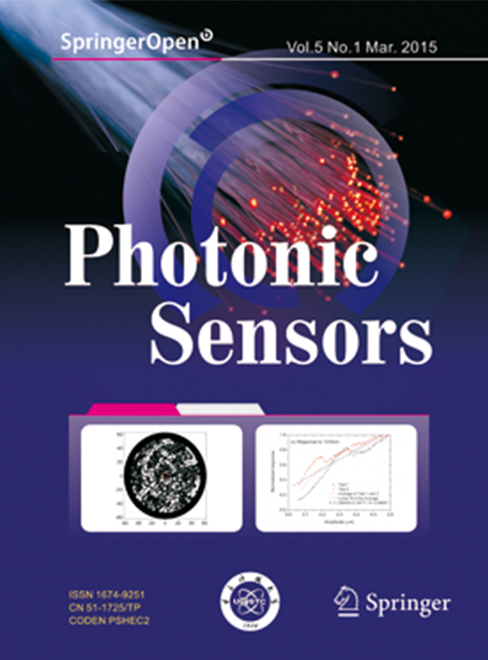 View fulltext
View fulltext
A brief review of recent progress made in a range of in-fiber integrated interferometers for measuring is presented, with particular attention paid to the multi-core based in-fiber integrated techniques, which have the potential to be exploited in a variety of wide applications.
In this paper, the mode coupling mechanism of tilted fiber Bragg gratings (TFBGs) is briefly introduced at first. And a general review on the fabrication, theoretical and experimental research development of TFBGs is presented from a worldwide perspective, followed by an introduction of our current research work on TFBGs at the Institute of Modern Optics, Nankai University (IMONK), including TFBG sensors for single-parameter measurements, temperature cross sensitivity of TFBG sensors, and TFBG-based interrogation technique. Finally, we would make a summary of the related key techniques and a remark on prospects of the research and applications of TFBGs.
As a low-dimensional optical fiber with diameter close to or below the wavelength of light, optical micro/nanofiber (MNF) offers a number of favorable properties for optical sensing, which have been exploited in a variety of sensing applications, including physical, chemical, and biological sensors. In this paper we review the principles and applications of silica, glass, and polymer optical micro/nanofibers for physical and chemical sensing.
An overview of fiber laser sensing is presented. The design and the characteristics of distributed feedback (DFB) fiber lasers for high performance sensing applications are described. Demodulation techniques based on unbalanced fiber interferometer are discussed, especially for the noise level, the dynamic range, and the crosstalk in dense-wavelength-division multiplexing. Finally, the fiber laser sensing system configurations and field demonstrations for different applications are illustrated.
Recent developments in spectral white-light interferometry (WLI) are reviewed. Firstly, the techniques for obtaining optical spectrum are introduced. Secondly, some novel measurement techniques are reviewed, including the improved peak-to-peak WLI, improved wavelength-tracking WLI, Fourier transform WLI, and 3 × 3 coupler based WLI. Furthermore, a hybrid measurement for the intensity-type sensors, interferometric sensors, and fiber Bragg grating sensors is achieved. It is shown that these developments have assisted in the progress of WLI.
Pressure sensors based on fiber-optic extrinsic Fabry-Perot interferometer (EFPI) have been extensively applied in various industrial and biomedical fields. In this paper, some key improvements of EFPI-based pressure sensors such as the controlled thermal bonding technique, diaphragm-based EFPI sensors, and white light interference technology have been reviewed. Recent progress on signal demodulation method and applications of EFPI-based pressure sensors has been introduced. Signal demodulation algorithms based on the cross correlation and mean square error (MSE) estimation have been proposed for retrieving the cavity length of EFPI. Absolute measurement with a resolution of 0.08 nm over large dynamic range has been carried out. For downhole monitoring, an EFPI and a fiber Bragg grating (FBG) cascade multiplexing fiber-optic sensor system has been developed, which can operate in temperature 300 ℃ with a good long-term stability and extremely low temperature cross-sensitivity. Diaphragm-based EFPI pressure sensors have been successfully used for low pressure and acoustic wave detection. Experimental results show that a sensitivity of 31 mV/Pa in the frequency range of 100 Hz to 12.7 kHz for aeroacoustic wave detection has been obtained.
Fiber sensors have been developed for industry application with significant advantages. In this paper, Fiber sensors for oil field service and harsh environment monitoring which have been investigated in Tsinghua University are demonstrated. By discussing the requirements of practical applications, the key technologies of long-period fiber grating (LPFG) based fiber sensor, optical spectrum analyzer for oil detection, laser induced breakdown spectroscopy (LIBS) system for soil contamination monitoring, and seismic sensor arrays are described.
The up to date progress of fiber sensing technologies in Tianjin University are proposed in this paper. Fiber-optic temperature sensor based on the interference of selective higher-order modes in circular optical fiber is developed. Parallel demodulation for extrinsic Fabry-Perot interferometer (EFPI) and fiber Bragg grating (FBG) sensors is realized based on white light interference. Gas concentration detection is realized based on intra-cavity fiber laser spectroscopy. Polarization maintaining fiber (PMF) is used for distributed position or displacement sensing. Based on the before work and results, we gained National Basic Research Program of China on optical fiber sensing technology and will develop further investigation in this area.








